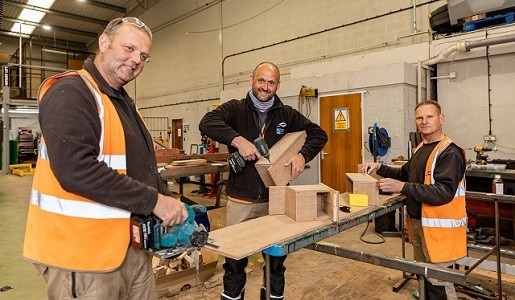Making homes for swifts
Thursday 29 April 2021
Telford & Wrekin Council, the RSPB and idverde are building homes for swifts which will be put up on council buildings to encourage pairs to nest and breed.

Swifts, almost never land, feeding, breeding and even sleeping on the wing, and with a recorded flight speed of 67mph, they certainly live up to their names!
They have seen a drastic decline in numbers in the last 25 years, with a 58% decrease in returning birds to the UK between 1993 and 2018. Not enough flying insects, climate change affecting their migration, and loss of suitable nesting sites are partly responsible for the decline, according to the RSPB which is calling for swift action.
Each year around this time, swifts return to the UK after spending the winter in sub-Saharan Africa – an epic journey of 3000+ miles. They meet up at the same nesting sites, usually in gaps under roof tiles and in the eaves of older buildings, and are easy to spot on a summer’s evening as they soar and race over rooftops.
They almost always nest in pre-WWII buildings, as those provide the cavities and access that replicate their preferred natural nesting sites. They also make very little mess and are considered one of the cleanest nesting birds in the UK.
As well as encouraging people to give swifts a home, the RSPB is asking them to record sightings on its Swift Mapper, a web-based mapping system and mobile app. The data will be used as a conservation planning tool to help halt the decline of this migrant species.
Ross Bray, community and nature engagement officer for RSPB/idverde partnership, said: “Swifts are on their way, so now is a great time to be putting up nesting boxes. The best time to look for nesting swifts is from late May to late July at dusk and early in the morning. Watch out for groups of swifts flying fast at roof height, often calling excitedly! This means that they’re breeding nearby.
“We would like to know if you see swifts entering holes in nearby buildings, so this is what we would like you to record on Swift Mapper. Please don’t record swifts flying high or feeding over water or fields, as they may not be local nesting birds.”
By logging where you see nesting swifts, you will be helping to build up a picture of where nesting sites need to be protected and where it would be best to provide new nesting sites.
Other ways you can help swifts is by putting up a swift box like the council is doing. In addition to swift boxes, crews are making nest boxes for other birds, bats and bugs too.
Cllr Carolyn Healy, Telford & Wrekin Council cabinet member for the natural environment and climate change, said: “Climate change, loss of habitat and nesting sites are having a devastating impact on so many animals. Lots of us enjoy seeing birds and bats flit across the sky and there are things we can do to help.
“Giving them a safe home, making our homes, gardens and green spaces more wildlife friendly, lessening pesticide use that can kill off their food sources, and recording what we see are just some of the ways we can all help.”
Learn more about Swift Mapper and helping swifts, helping bats and helping birds.
The council will continue to work with the RSPB in partnership with idverde to create more homes for birds, bats, and bugs, and encourage others to do the same. Local churches, schools and businesses are also being urged to get involved and set up swift nesting sites. If you would like more information on how you can help, please email Ross at ross.bray@idverde.co.uk.